15 Types Of SMALL BLACK And WHITE BIRDS (Guide With Photos)
Did you recently come across a small black and white bird, and want to know what species it was?
Identifying small birds that have both white and black markings is not as easy as it might seem, since there are surprisingly many birds in North America that fit this description.
To help you identify the bird you saw, we’ll cover all the small black and white birds of North America in this guide.
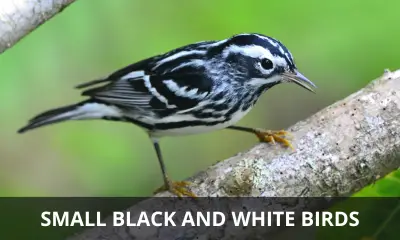
What small birds are black and white?
There are 15 types of small black and white birds in North America, which are covered in full detail below.
Black and White Warbler
Scientific name: Mniotilta varia
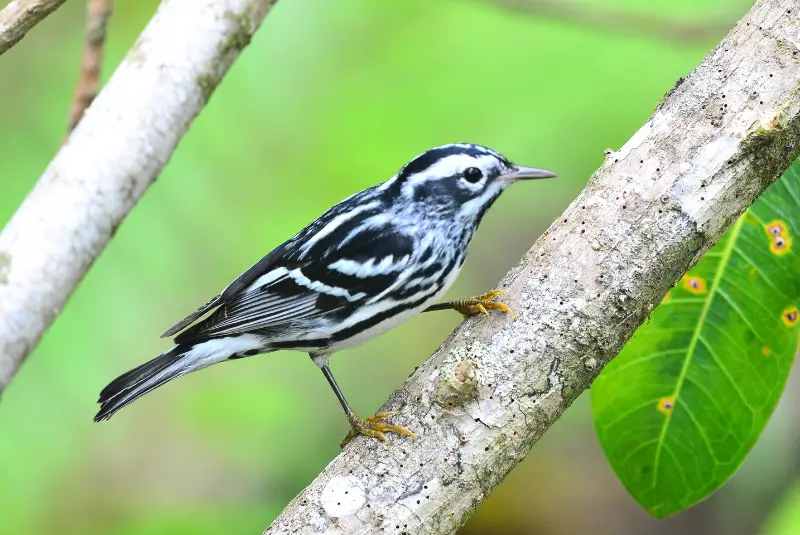
The Black and White Warbler is a small songbird that has black upperparts with white streaks, as well as distinctive black wings with two white wing stripes.
When its wings are folded, the white stripes look more like white spots on a black background.
Unlike many other warblers, female Black-and-white Warblers look very similar to the males, except for lacking the dark patch behind and below their eye, which increases the white area on their head.
The Black and White Warbler is a breeding bird in the eastern parts of North America, where it can be found from May to August from Canada in the north, to Texas in the south.
This little bird is a seasonal migrant that spends the winter in Central America, with a small percentage of its population wintering in Florida and the Gulf Coast.
It can be found in a range of diverse forest habitats, and feeds on small insects and other invertebrates.
Lark Bunting
Scientific name: Calamospiza melanocorys
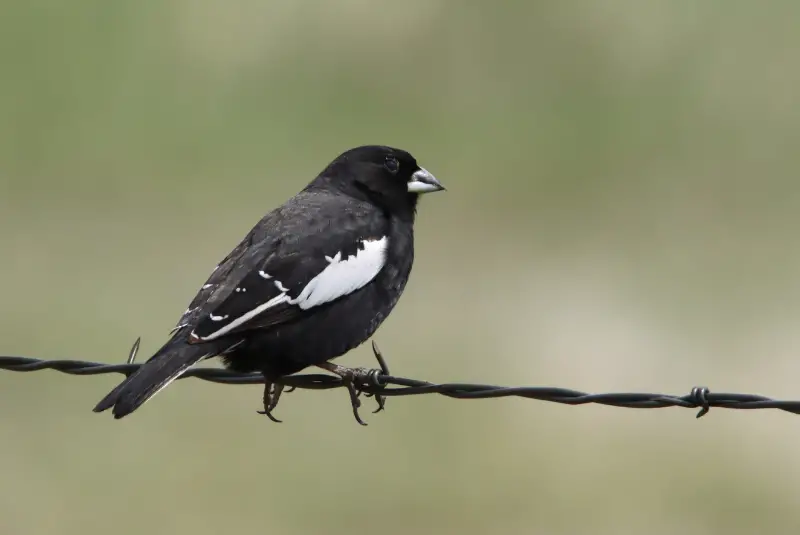
The Lark Bunting is a medium-sized songbird with striking black-and-white coloration in the male.
Male Lark Buntings are mostly black with a bright white stripe on their wings. The females and juveniles, on the other hand, are pale brown with black wings that have white streaks.
The Lark Bunting is a summer visitor in the central part of North America, with a range that extends northwards up to Canada.
During the migration season in fall, this black and white bird forms large flocks that fly south together. It winters in Mexico and the southern United States.
The preferred habitat of the Lark Bunting are prairies and grassland, where it forages for seeds and small invertebrates during summer.
Black Phoebe
Scientific name: Sayornis nigricans

The Black Phoebe is easily recognizable because of its striking white and black appearance.
Adults males and females look similar, and have a black back, head and chest, which fades into dark gray towards the rump, and a white belly and under tail region.
Juveniles are broadly similar to adult birds but have brown feather fringes on their wings and back.
The Black Phoebe is found in the southwestern United States, where it occurs all year round and can be easily observed because it is not afraid of people.
It often perches in the open and catches insects while flying. One of its unique behaviors is that it waves its black tail up and down when it is sitting.
Black-capped Chickadee
Scientific name: Poecile atricapillus
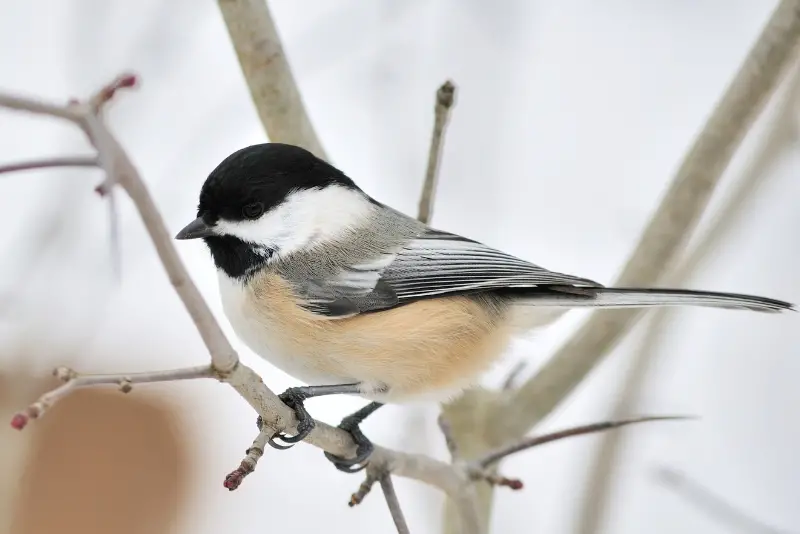
The Black-capped Chickadee is a common bird species in North America. Both sexes look similar, and have gray backs with buff underparts.
Their most distinguishing feature is the black cap and the black bib, which contrasts with the bright white cheeks.
This chickadee is present year-round in North America, where it favors a variety of woodland habitats as well as backyards.
These birds are regular visitors at bird feeders, and also readily accept nestboxes.
Carolina Chickadee
Scientific name: Poecile carolinensis
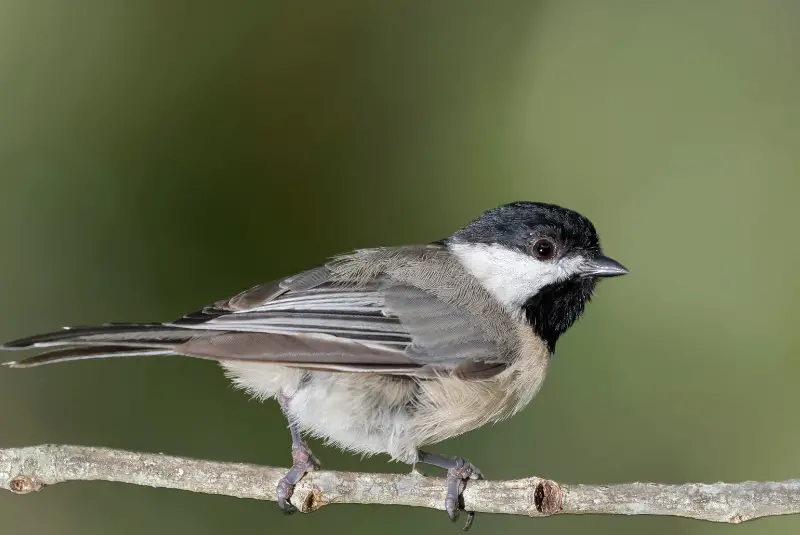
The Carolina Chickadee is easily identifiable by its black cap and bib. Both sexes look similar and have a grayish back and buff white underparts.
Similar to the previous chickadee species, Carolina Chickadees have black and white heads. They are non-migratory birds that nest in deciduous forests across North America.
The Carolina Chickadee readily visits backyard feeders, and has a preference for sunflower seeds. It also accepts nest boxes as a substitute for treeholes.
White-breasted Nuthatch
Scientific name: Sitta carolinensis
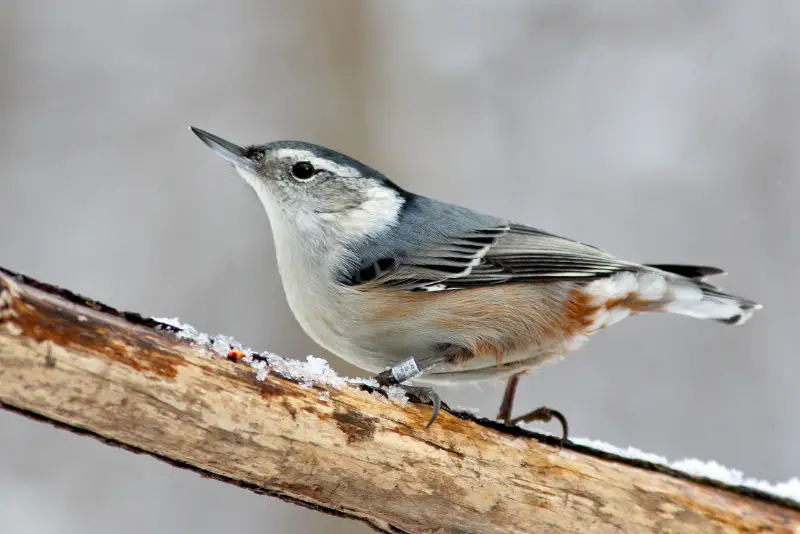
This is the largest Nuthatch species in North America, and is a common year-round resident in large parts of North America.
Adults have a grayish blue back and wings, as well as a white face, throat, and breast.
These little birds favor deciduous or mixed forests, and are common visitors at tube feeders offering sunflower seeds.
Outside of the breeding season White-breasted Nuthatches form small flocks with other species of songbirds, which rove around and forage together.
Blackpoll Warbler
Scientific name: Setophaga striata
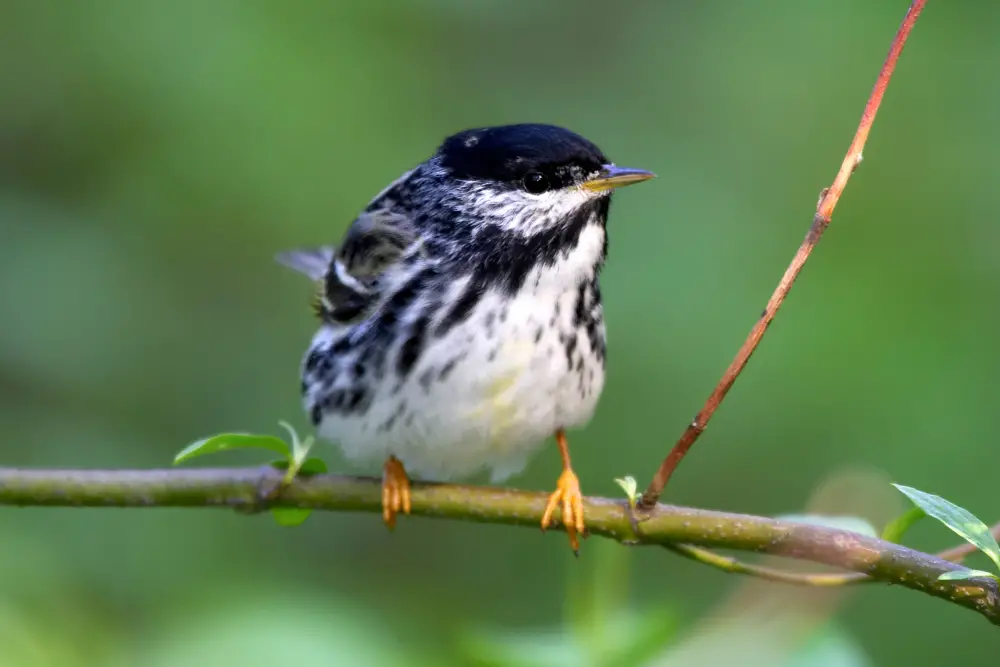
The Blackpoll Warbler is a visually striking little warbler that inhabits the northern forests of North America during its breeding season, which typically lasts from June to August.
Similar to all warbler species, this little black and white bird migrates south in fall, to spend the winter in northern South America.
The sexes of the Blackpoll Warbler are dissimilar, with adult summer males exhibiting a dark, streaked back and nape, a black cap, a white face, and a black malar stripe.
Their black wings boast two white wingbars, and their underparts are white with bold black streaks on the flanks.
Downy Woodpecker
Scientific name: Picoides pubescens

The Downy Woodpecker is the smallest species of woodpecker found in North America.
The males are small black and white woodpeckers with a small red patch on their nape, females lack the red spot on their head.
The wings of these birds are black with white stripes, which resemble spots when the wings are folded.
Downy Woodpeckers are non-migratory, and can be seen all year round throughout North America, except for arid regions in southern states.
You can tell this bird apart from the similar Hairy Woodpecker by its smaller size and short beak.
While Downy Woodpeckers don’t migrate, they like to move around outside of the breeding season, in search of areas with plentiful food.
Their preferred habitat is deciduous or mixed forest, where they feed on insects and insect larvae found under the bark of trees. During winter they also eat berries and seeds.
Hairy Woodpecker
Scientific name: Picoides villosus

The Hairy Woodpecker looks similar to the Downy Woodpecker, but has a longer, thicker bill, and is a much larger bird overall.
Both the male and the female have black upperparts with white stripes consisting of white feathers on the wings (though they look more like spots when the wings are folded).
The male has a very small red patch on the back of its head, which is considerably smaller than the red patches on other woodpecker species.
The Hairy Woodpecker is a common breeding bird found throughout North America, and is a year-round resident.
This woodpecker breeds in both coniferous and deciduous forests, and is even found in parks and other urban areas with trees.
Related: Guide to the large black and white birds
Acorn Woodpecker
Scientific name: Melanerpes formicivorus
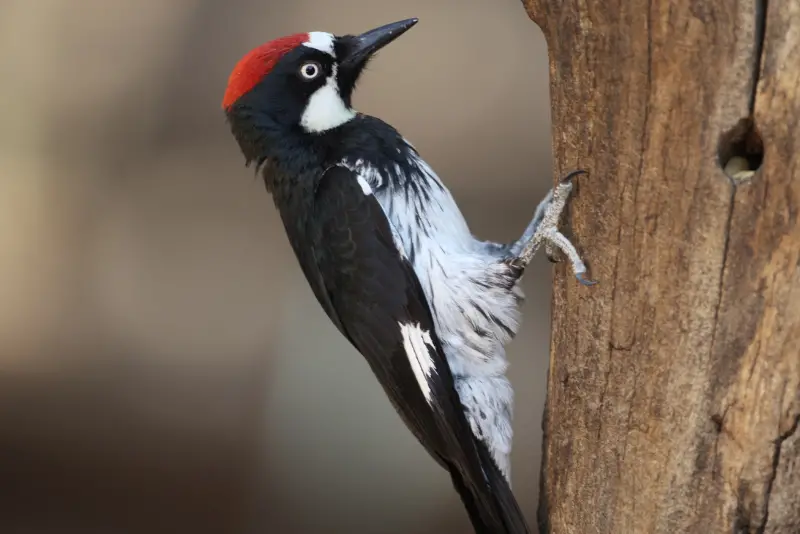
The Acorn Woodpecker is a colorful small woodpecker that only occurs in a few areas of the southwestern and western United States.
While the back and wings of these birds are entirely black, their face has a large white patch on the throat and forehead, while the belly is white with black spots.
Both sexes also have a bright red patch on top of their head, and they are usually observed as part of a social group that forages together for acorns in open oak forests.
They store their acorns in trees that are riddles with small holes created by a group of Acorn Woodpeckers. These little black and white birds also nest communally, and cooperate in raising their young.
Dark-eyed Junco
Scientific name: Junco hyemalis

Dark-eyed Juncos are small gray-colored sparrows that are common breeding birds in the mountains of California. They can also be seen in other parts of the state during winter.
Male juncos are blackish gray with a white belly, while females and immature birds are duller and browner.
These birds breed in coniferous as well as mixed forests of western California and during winter they can be found in a variety of habitats, including backyards, forests, and meadows.
They feed on seeds which they pick up from the ground, and can be easily recognized by the high pitched sounds they make while foraging.
Eastern Towhee
Scientific name: Pipilo erythrophthalmus
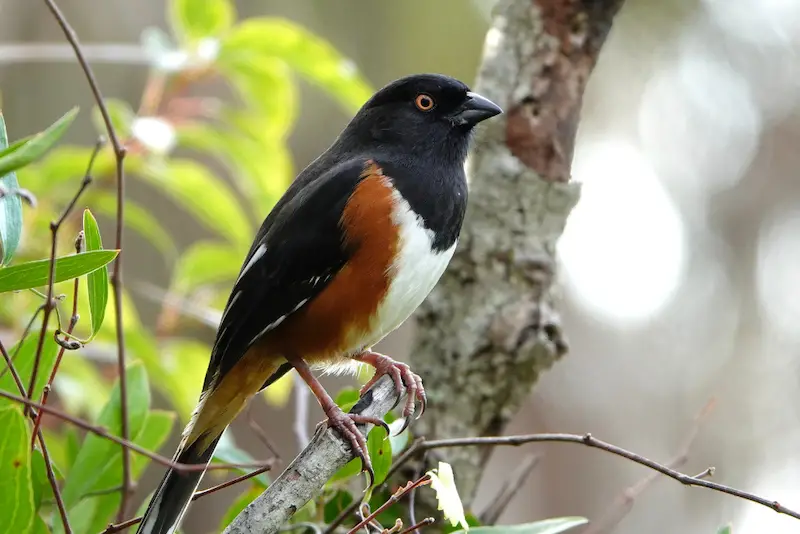
Towhees got their name from the characteristic “Tow-hee” cry that both genders use.
Male Eastern Towhees are black mixed with white, combined with rusty-brown sides and a white underside.
When the Eastern Towhee takes to the air, white comma-shaped wing patches become visible on the upper side of its wings.
Although the female incubates the eggs until they hatch, the male does the heavy lifting when it comes to feeding the young.
The Eastern Towhee, similar to all other species of towhee, forages by making a comical backwards hopping motion with both feet at the same time.
It does this in order to displace leaves and expose the seeds and insects that are concealed under them.
You can readily attract these little birds to your feeder with black oil sunflower seeds.
Rose-breasted Grosbeak
Scientific name: Pheucticus ludovicianus
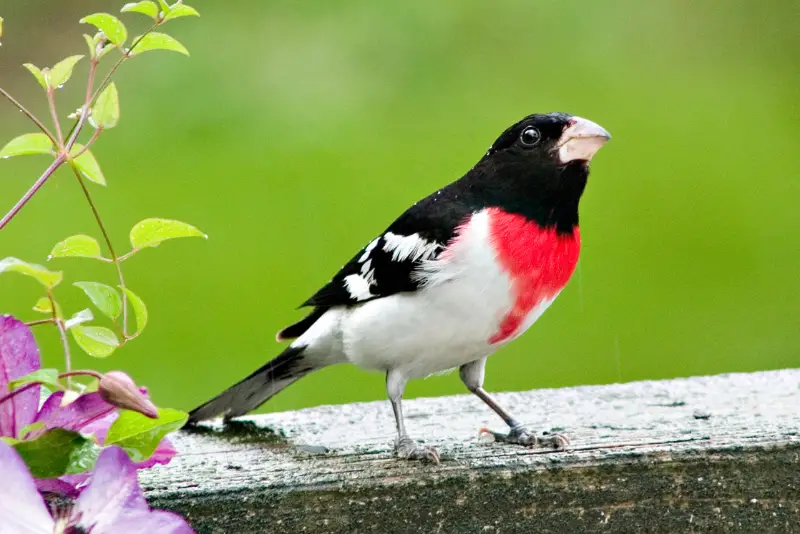
The Rose-breasted Grosbeak is easily identifiable due to its distinct markings and its large beak.
During the summer, adult males have a scarlet red chest, which contrasts with their jet black hood and back, and their black wings have white wing bars.
Adult females and immatures, on the other hand, have streaked brown plumage that is lighter on the underside than on the back. They also have a white eyebrow stripe and white wingbar.
This bird can be seen in North America during the summer only, as it is a migratory bird that migrates to Central America to spend the winter months.
Yellow-bellied Sapsucker
Scientific name: Sphyrapicus varius
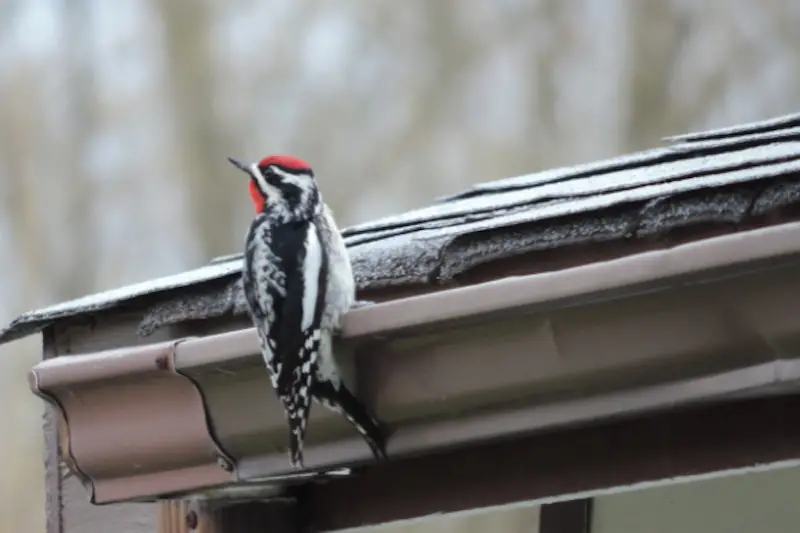
The Yellow-bellied Sapsucker is a breeding bird of Canada and the northernmost United States, but can be encountered wintering in southwestern states during the cold months.
The male has checkered black and white markings on its back, which contrast with a red crown, forehead, and chin. It also has a yellowish tinge on its belly and chest. The female looks similar to the male, but has a white chin.
The Yellow-bellied Sapsucker is found in small forests, as well as rural and suburban areas. It drills holes into trees in order to drink the sap that oozes out, which it.
The bleeding sap also attracts insects, which the Yellow-bellied Sapsucker feeds on.
Final remarks
In summary, these are the15 types of small black-and-white birds in North America:
- Black-and-white Warbler
- Lark Bunting
- Black Phoebe
- Black-capped Chickadee
- Carolina Chickadee
- White-breasted Nuthatch
- Blackpoll Warbler
- Downy Woodpecker
- Hairy Woodpecker
- Acorn Woodpecker
- Dark-eyed Junco
- Eastern Towhee
- Rose-breasted Grosbeak
- Yellow-bellied Sapsucker
If you’ve spotted one of these birds while bird watching in your backyard, hopefully this ID guide will help you identify it quickly and easily.
And if you enjoyed this article, check out our guide to the black and white birds that have a red head.
